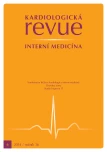Monoclonal PCSK9 antibodies in the treatment of dyslipidemias
Authors:
M. Vráblík
Authors‘ workplace:
Centrum preventivní kardiologie, 3. interní klinika 1. LF UK a VFN v Praze
Published in:
Kardiol Rev Int Med 2014, 16(6): 485-488
Category:
Cardiology Review
Overview
The use of targeted therapy with monoclonal antibodies is not yet the standard care in cardiology. However, this approach seems feasible for a number of reasons (e. g. high therapeutic efficacy, lower potential for drug‑drug interactions, the possibility of alternate dosing). The identification of a novel protein (proprotein convertase subtilisin/ kexin 9 – PCSK9) grossly impacting on serum LDL‑cholesterol levels led to the preparation of specific monoclonal antibodies blocking its function. This interaction results in a dramatic decrease of LDL‑cholesterol (and other atherogenic lipoproteins) in the serum by 50– 70% above the level achievable by currently available therapies. The safety and efficacy of PCSK9 inhibitors is being tested in a large research program of several manufacturers. This new therapeutic option may offer hope for difficult‑ to‑ treat patients with familial hypercholesterolemia or statin intolerance, and, in the future, possibly also for patients at high cardiovascular risk not achieving LDL‑cholesterol targets with currently available therapies.
Keywords:
cardiovascular risk – LDL‑cholesterol – lipid lowering drugs – PCSK9 – monoclonal antibodies
Sources
1. Vrablík M, Češka R. Novinky v oblasti hypolipidemické léčby. Vnitř Lék 2014; 60: 924– 932.
2. Cuchel M, Bloedon LT, Szapary PO et al. Inhibition of microsomal triglyceride transfer protein in familial hypercholesterolemia. N Engl J Med 2007; 356: 148– 156.
3. Kastelein JJ, Wedel MK, Baker BF et al. Potent reduction of apolipoprotein B and low‑ density lipoprotein cholesterol by short‑term administration of an antisense inhibitor of apolipoprotein B. Circulation 2006; 114: 1729– 1735.
4. Sacks FM, Stanesa M, Hegele RA. Severe hypertriglyceridemia with pancreatitis: thirteen years' treatment with lomitapide. JAMA Intern Med 2014; 174: 443– 447. doi: 10.1001/ jamainternmed.2013.13309.
5. Seidah NG. PCSK9 as a therapeutic target of dyslipidemia. Expert Opin Ther Targets 2009; 13: 19– 28. doi: 10.1517/ 14728220802600715.
6. Catapano AL, Papadopoulos N. The safety of therapeutic monoclonal antibodies: implications for cardiovascular disease and targeting the PCSK9 pathway. Atherosclerosis 2013; 228: 18– 28. doi: 10.1016/ j.atherosclerosis.2013.01.044.
7. Abifadel M, Varret M, Rabes JP et al. Mutations in PCSK9 cause autosomal dominant hypercholesterolemia. Nat Genet 2003; 34: 154– 156.
8. Zhao Z, Tuakli‑ Wosornu Y, Lagace TA et al. Molecular characterization of loss‑ of‑ function mutations in PCSK9 and identification of a compound heterozygote. Am J Hum Genet 2006; 79: 514– 523.
9. Cohen JC, Boerwinkle E, Mosley TH Jr et al. Sequence variations in PCSK9, low LDL, and protection against coronary heart disease. N Engl J Med 2006; 354: 1264– 1272.
10. Abifadel M, Elbitar S, El Khoury P et al. Living the PCSK9 adventure: from the identification of a new gene in familial hypercholesterolemia towards a potential new class of anticholesterol drugs. Curr Atherosclerosis Rep 2014; 16: 439. doi: 10.1007/ s11883‑ 014‑ 0439‑ 8.
11. Hansel TT, Kropshofer H, Singer T et al. The safety and side effects of monoclonal antibodies. Nat Rev Drug Discov 2010; 9: 325– 338. doi: 10.1038/ nrd3003.
12. Stein EA, Mellis S, Yancopoulos GD et al. Effect of monoclonal antibody to PCSK9 on plasma LDL cholesterol. N Engl J Med 2012; 366: 1108– 1118. doi: 10.1056/ NEJMoa1105803.
13. Stein EA, Wasserman SM, Dias C et al. AMG‑ 145, Evolocumab. Drugs of the Future 2013, 38: 451– 459.
14. Alirocumab Effectively Lowers LDL Cholesterol in Nine Trials: Top‑ Line Results from ODYSSEY. Medscape 2014; Jul 30. [online] Available from: http:/ / www.medscape.com/ viewarticle/ 829130.
15. Blom D, Hala T, Bolognese M et al. A 52‑week placebo‑ controlled trial of evolocumab in hyperlipidemia. N Engl J Med 2014; 370: 1809– 1819. doi: 10.1056/ NEJMoa1316222.
Labels
Paediatric cardiology Internal medicine Cardiac surgery CardiologyArticle was published in
Cardiology Review

2014 Issue 6
Most read in this issue
- Aortic diseases – diagnosis, classification and management principles
- Combination of anticoagulant and antiaggregant treatment in patients after myocardial infarction with an indication for anticoagulant treatment – so‑ called triple therapy
- Triple-combination in the treatment of hypertension
- When to recommend a combination of ACE-inhibitors and angiotensin receptor blockers
